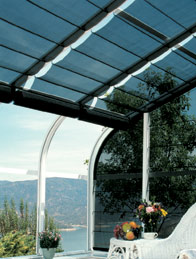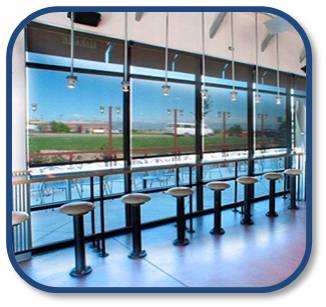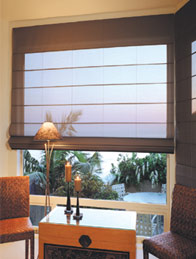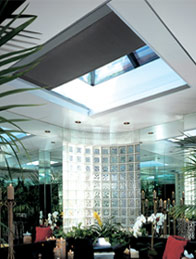|
DWF Contract Roller Shades
Clutch-operated lifting system is standard; motorization is an optional add-on. |
| Fascias and headboxes are available in various sizes. |
|
DWF Contract Roller Shades are compact when opened (drawn up). Since the fabric rolls up, the shade does not require the “stacking space” of a traditional folding shade. When the shade is down, the deployed fabric is smooth and uncluttered, providing simple and elegant sun protection and privacy. During the day, the solar-screen fabrics allow a clear view through the window, while blocking the view into the building from outside. In the evening, when the source of light is inside, additional window treatments such as draperies might be needed to provide night-time privacy. |
| The simple, uncluttered look of this product, its functional advantages, and its cost effectiveness, combined with DWF Contract Roller Shades superior parts and craftsmanship, make it extremely popular. |
|
DWF Contract Roller Shades can be made for window openings up to 240″ wide. |
| If complete blackout is required, the shade can be made in blackout fabric with side and bottom channels and a headbox or fascia. |
DWF Contract Folding Shades
|
A DWF Contract Folding Shade is finished neatly with a round bottom rail rather than a hem. |
| Lifting cords run from the bottom of the shade through a series of pulleys and cord guides (rings attached to the shade). The cords lift the shade from the bottom, causing the shade to form a series of folds as it rises. |
| Because solar fabrics with vertical seams do not fold neatly, we cannot make the DWF Contract Folding Shade with center panels or center seams. Instead, we railroad the fabric (turn it at a 90 degree angle) and conceal any horizontal seams in the stay pockets. |
| DWF Contract Folding Shade have no side hems. Because of the quality of the solar fabrics, side seams are not necessary; and the additional thickness might impair the operation of the shade. The fabric edges are neatly finished. |
| Both manual and motorized lifting systems are available. |
| The classic look of a DWF Contract Folding Shade makes it desirable in situations where some design detail is preferred. Stays running from side to side add structure, giving the shade an “architectural” look. |
| As with DWF Contract Roller Shades, the folding shades allow a clear view through the window during the day, while blocking the view in from outside. |
DWF Contract Greenhouse Shade

| The DWF Contract Greenhouse Shades are an ideal solution for treating curved windows, and are typically used in solariums and greenhouses. |
| The shade design is a variation on the folding shade style, with engineering modifications to allow smooth operation over curved windows. The sides of the shade are held in place by carriers that run along a fixed track. |
| The DWF Contract Greenhouse Shade is lifted from the bottom, creating the folded stack that is characteristic of a folding shade. These shades are used in situations where the slope of the glass is sufficient to use gravity in bringing it down. The path of the shade is guided by tracks, and special carriers attached to the shade travel along the tracks. |
| Most DWF Contract Greenhouse Shades are made up in solar-screen fabrics, but other fabrics can be used as well. |
|
Both manual and motorized lifting systems are available. DWF Contract Skylight Shades
|
| For windows that are flat and rectangular but without a vertical slope, a DWF Contract Skylight Shade is usually the preferred solution. |
The DWF Contract Skylight Shade is a complete roll shade and motorized lifting system. It can be manufactured with any fabric suitable for roll shades. The system can be fabricated in several ways:
|




